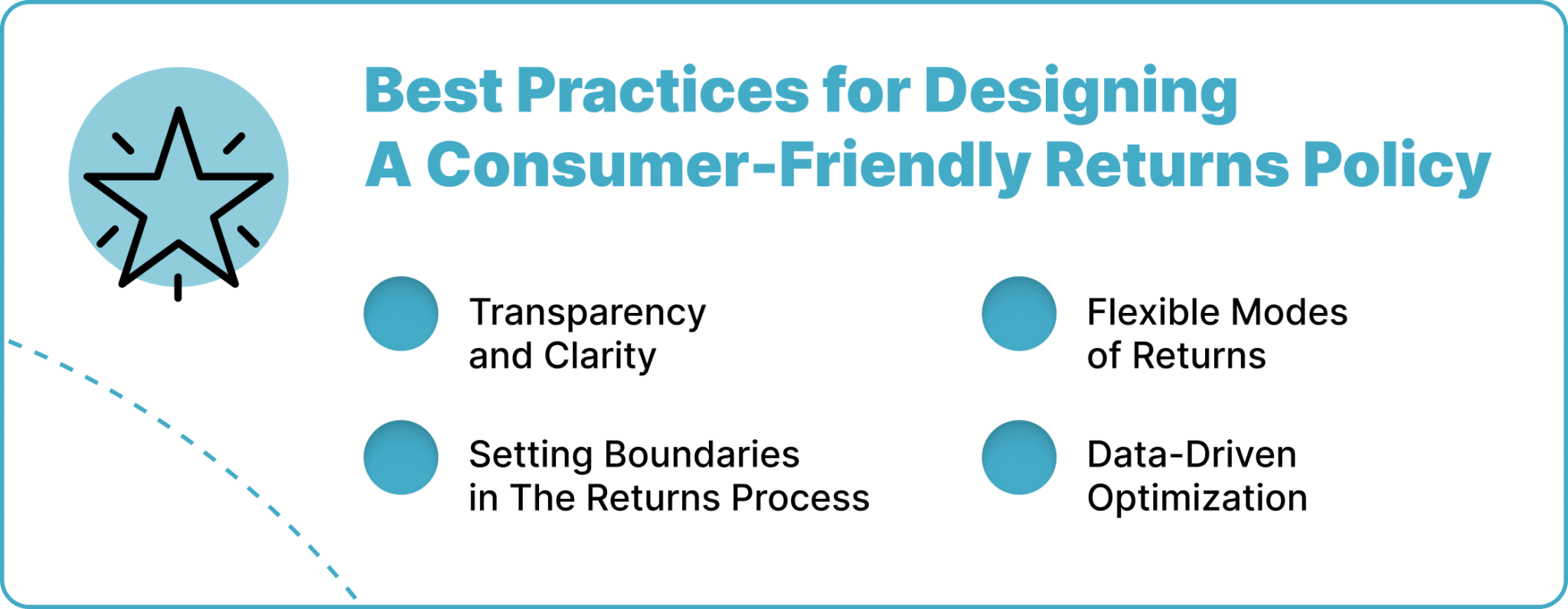Developing Consumer Friendly Returns Policy: Best Practices For Retailers

30% of customers will return their purchases. You can do little about it besides having an effective returns management process. It goes a long way in facilitating effective inventory analysis and control across the board. However, you need a consumer-friendly returns policy for an effective return process.
A good returns policy is key to successful return management system implementation. The primary reason is that it prioritizes consumers, who are the ultimate end users of the supply chain. It also helps retailers streamline the process for effectiveness. In the complex world of supply chain management, retail businesses need all the help they can muster to simplify their operations.
But what is a Returns Policy?
A returns policy is a set of terms and conditions guiding the reverse logistics process. The system informs customers about the structure of the returns management operation and how they can relate to it. Customers want the option of returning purchased goods if they do not get what they want. But, beyond having one, you must have a system they can seamlessly engage with. Designing your RMS with an easily relatable returns policy is critical to enjoying success.
In this article, we will explore four of the best practices for developing a consumer-friendly returns policy.
Best Practices for Designing A Consumer-Friendly Returns Policy
To get a consumer-friendly returns policy, you must design it to meet the needs of all consumers, irrespective of their purchasing history or background. Ideally, your returns policy must have a few traits to achieve that. The best practice for drafting a consumer-friendly returns policy.

Transparency and Clarity
Today, retail supply chains or businesses prefer to target a single customer avatar (the ideal marketing persona a business wishes to sell to). But in reality, their customers span across a wide variety of customers from different sectors of the economy. This means that your consumers will mostly or generally have varying backgrounds. The problem here is that it can be difficult to predict who will return because customers have varying reasons for doing that. This means your returns policy must be designed so that any customer from any background can understand it without much fuss.
There are three keys to ensuring transparency and clarity in the return policy. It must be easy to understand, specific, and consistent.
Easy to understand: Make your returns policy readily available on the website or application you sell to the customer. It must be written in simple language and wording. This helps avoid legal jargon and ensures that the customers are well-informed before engaging in the returns process. It can also save you a lot of hassle in the future and drive customer loyalty.
Specific: The returns management must be specific about the rules that serve as guard rails for the policy. Customers should be able to find the accepted returns window, items that can be returned, and the available modes of returns.
Consistent: You don’t want to say one thing and act another way. That is a quick way to lose customers. If you make changes to the returns policy on the back end, be sure to update it on the front end for customers to peruse. If possible, update them through notifications and alerts when you make changes. This way, you can avoid confusion.
Flexible Modes of Returns
The truth is customers generally do not enjoy returning items. However, they do it to ensure they get value for money. When creating a return policy, it is essential to consider the customer’s convenience. After all, nearly 80% of them will not shop with a retailer offering them a poor return experience.
One way to improve the customer’s overall experience is by providing them multiple means to return their purchases seamlessly. For example, those close to the store who want to and can come to the store should be able to do that. And for those unable to, you can either facilitate a pick-off or encourage customers to return via mail.
Having multiple return options makes the consumer feel like they are in control. Of course, it also ensures they can pick whichever option is more convenient for them and sometimes the retailers. For instance, if the retailer cannot meet up with the recollection of the item, and the customer has to travel, they could take it to the store to ensure the process is started immediately.
Setting Boundaries in The Returns Process
Boundaries are important to avoid foul play and abuse of the system. It relates to the earlier point about being clear on the returns policies. You want to set conditions and deadlines for returns on the items. Boundaries are effective because they help prevent abuse of the entire process. They also help build customer trust in the brand.
Consider the other organizations within your industry and general industry standards when setting up your returns policy. This way, you have a guide on what to do.
Data-Driven Optimization
Your return policy may not be the best when it starts. This is for several reasons, including the uniqueness of the product and how customers interact with your system. That shouldn’t be the same for too long, though. Over time, your returns policy should be able to adapt to consumer preferences and behaviors.
This means optimizing it for more impact and customer satisfaction. It is an excellent strategy to ensure repeat business. To do this, invest in tracking customer returns and determining why they return purchased items. Some of the reasons could be damaged goods, wrong size, or a change of heart.
When you have done these successfully, the next step will be to refine or optimize the returns policy using available data. Adjust or make improvements where you need to and relax some of the boundaries if needed. Continuously refining your returns policy will enhance experiences, help you meet customer expectations, and potentially help customers make the most of their purchases from your platform.
How ReverseLogix Can Help You Draft a Friendly Returns Policy That Works
You cannot have a consumer-friendly policy without having a consumer-friendly returns management operation. The latter ought to come first. However, they work hand in hand. It is the returns management that informs the returns policy. And it is the returns policy that helps the consumer interact effectively with the returns management system.
This is where Reverselogix comes in. We help you set up the right returns management system for your reverse logistics operations. Our solutions are robust and all-encompassing. They have helped numerous businesses improve customer experience and satisfaction by 15% to 20%. We can do the same for you.
Get started today with the right tool that will inform your returns policy. Remember, the more effective it is, the more your customers will engage with it seamlessly. View our pricing plans or schedule a demo with ReverseLogix.
Frequently Asked Questions
Q1: How can a return policy benefit my business?
It’s all about attracting and keeping customers. A consumer-friendly return and refund policy builds trust and gives the customers an excuse to spend more on your platform. Because they know they can quickly return the purchased items if needed.
Q2: How can I prevent people from abusing the return policy?
If there is room for abuse, many customers will take it. The following can help you prevent that, though. A reasonable return window, clarity on non-returnable items, charging shipping fees, limiting returns depending on the original payment method, and optional restocking fees.
Q3: How can I use return data to improve my business?
Analyze return trends to identify reasons for returns (e.g., sizing issues and product descriptions). Use this data to improve product offerings and communication strategies. It will potentially reduce unnecessary return shipping costs in the long run and enhance customer satisfaction.
Q4: What are some best practices for handling returns in-store?
You can start by training staff to handle returns courteously and efficiently. Empower them to offer solutions like encouraging the exchange of items with equal value or within the same purchase price, facilitating a seamless refund process, or offering store credit whenever possible to maintain a positive customer experience.
